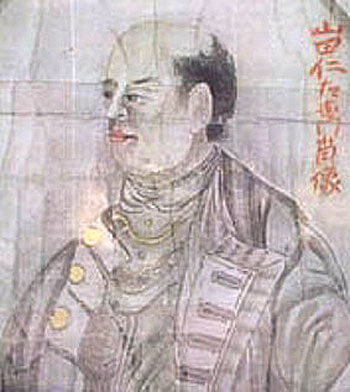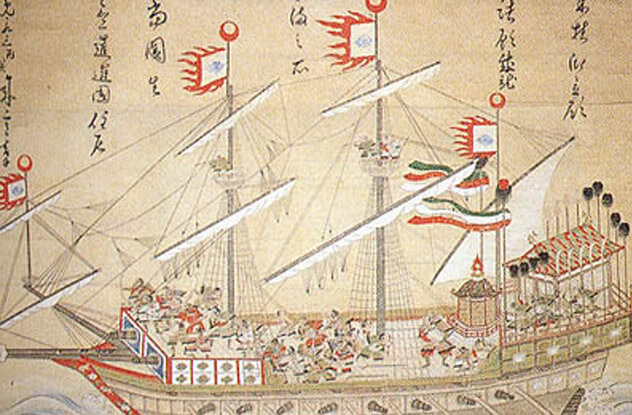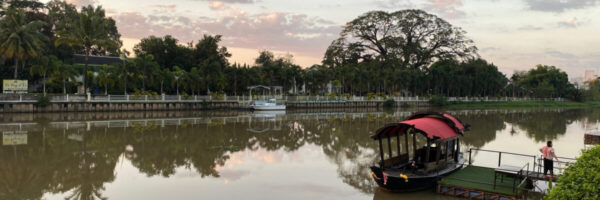
Thai Samurai – The Life of Yamada Nagamasa
Thailand has had a fascinating history of unique “farangs” who came here to live and work throughout its recent history: Constantine Phaulkon – prime minister to King Narai of Ayutthaya; Jim Thomson – the American silk king of Thailand; billionaire William E. Heinecke – Head of Minor International, a huge regional conglomerate and Louis T. Leonowens – an early important English trader whose firm still exists as a major company, amongst others. However, the Japanese merchant warrior, Yamada Nagamasa, can easily take his place on this unique list.
Nagamasa was born in Otani, Numazu, Shizuoka, Japan in 1590. Supposedly he started his career as a palanquin bearer for the Lord of Numazu. He eventually became involved in Japanese trade activities with SE Asia when Japan officially authorised ships to trade outside the country. He settled in the Ayutthaya about 1612. Nagamasa had a spectacular rise while there under King Songtham. From 1617 and beyond he was the head of the Thai village inside of Ayutthaya called “Baan Yipun” (or Japanese village). This village had roughly 1,000 Japanese residents. It was run by a Japanese headman who was nominated by Ayutthayan authorities. The village’s inhabitants were a combination of several hundred Christian converts who had fled Japan following the religious persecutions of Tokugawa Leyasu and Toyotomi Hideyoshi. There were also Rōnin (unemployed former Samurai) who had been on the losing side at the battle of Sekigahara (1600) or the Siege of Osaka (1614-15) and other merchant traders.
The Japanese colony was very active in trade. The most important export to Japan were deer hides. In return, Japan exported silver and highly valuable handicrafts like swords, high quality paper products and lacquer boxes. The Japanese were in direct competition for regional trade with the Dutch East India Company’s (initials V.O.C.) monopoly based in what is now Indonesia. Nagamasa supposedly carried on business as a privateer from the period of about 1620. He was said to have attacked and plundered Dutch ships in and around Batavia (now Jakarta). After more than 12 years in Ayutthaya, Nagamasa went to Japan in 1624 on a trade mission. He sold a cargo of Siamese deer hide in Nagasaki. He remained in Japan until 1627. He departed with the simple status of a foreign ship without an official trading license. On his return Nagamasa rose from the rank of “Khun” to the elevated rank of “Ok-ya Senaphimuk”.
The Japanese colony also offered valuable military services to Ayutthaya. The King organised a group of Japanese military volunteers. Nagamasa supported the military campaigns of King Songtham as the head of a Japanese army. In 1628, his ships were carrying rice from Ayutthaya to Malacca. Nagamasa was arrested by a Dutch warship blockading the city on one journey, but once his identity became known he was immediately released. The Dutch knew Nagamasa was held in great respect by the King of Ayutthaya. They did not want to spark a diplomatic conflict. He was also a supplier of deer hide to the Dutch. They sought more of his trade.
However, Nagamasa’s luck finally ran out when he got in the middle of the successor war for the throne. King Songtham died in late 1628. The King entrusted Phraya Siworawong, or Prasat Thong, to be the regent to his son. Prasat Thong acted as “king-maker” and eventually executed both of King Songtham’s sons and anyone else who opposed his reign, usurping power. Once Nagamasa heard King Songtham had died he objected. Now King, Prasat Thong sent Nagamasa as the governor of Ligor (now Nakhon Si Thammarat) in 1630 to get rid of him.
A few months later Prasat Thong then had Praya Chaiya secretly poison Nagamasa. Then the new King sent an army of 4,000 soldiers to destroy the Japanese settlement in Ayutthaya. But many Japanese managed to escape to Cambodia. In 1633 several hundred Japanese managed to return and reestablished another residence in Ayutthaya. In 1634, the Japanese Shogun was informed about these problems and refused to issue official authorisations for trade ships to Ayutthaya. The Ayutthaya King was still desirous to retain Japan’s trade and sent a trade mission in 1636. But the Shogun rejected the offer and formal relations between the two countries came to an end until the 19th century. Japan then closed itself off from the world. The Dutch promptly stepped in to fill the trading void.
Nagamasa’s grave is now in his home town of Otani.








